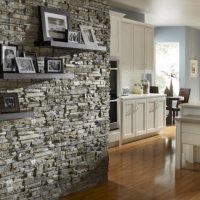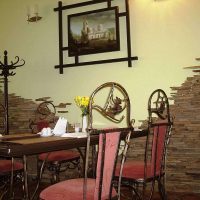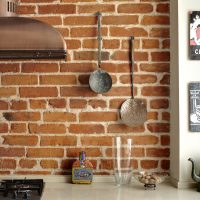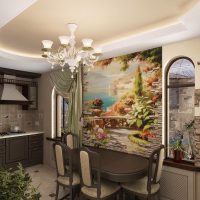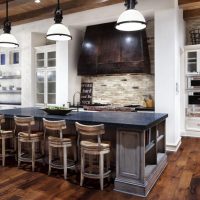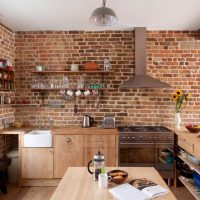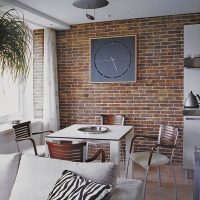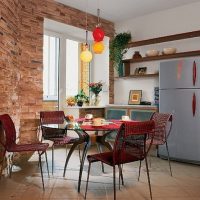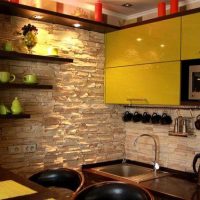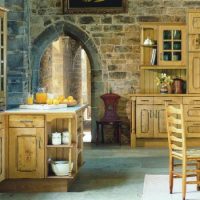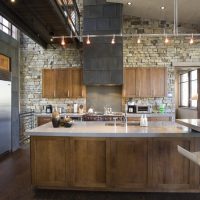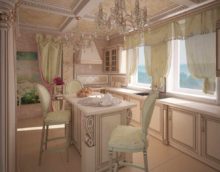Features of the use of decorative stone in the interior of the kitchen
They produce artificial decorative stone from natural raw materials: quartz, clay, granite chips, feldspar. Therefore, this finishing material is environmentally friendly and has good characteristics in order to be popular.

Decorative stone attracts with its lively structure, volume and natural look
Content
Varieties
There are three types of artificial stone:
- porcelain tile;
- agglomerates;
- colored concrete brick and stone.
Most often, porcelain stoneware is used for facing work with a working area, window sills or floors. In the kitchen, it is widely used for countertops, which, thanks to the monumental appearance, give the interior a more noble and elegant look.

Porcelain countertops can last for decades
In appearance, acrylic stone (agglomerates) imitates natural minerals and their structure. It is also used for furniture surfaces, wall decoration and kitchen aprons.
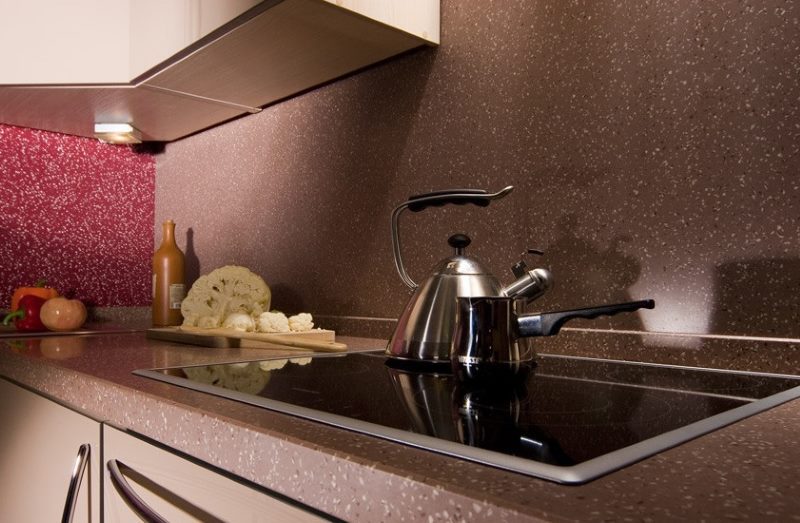
Thick acrylic stone is suitable for work surfaces, thin sheets are ideal for wall decoration and kitchen apron
Colored concrete is produced using cement and sand. Get products that mimic a brick, shell rock, savage. Most often used for wall cladding in various interior design options, where imitation of masonry or stone wall is required.
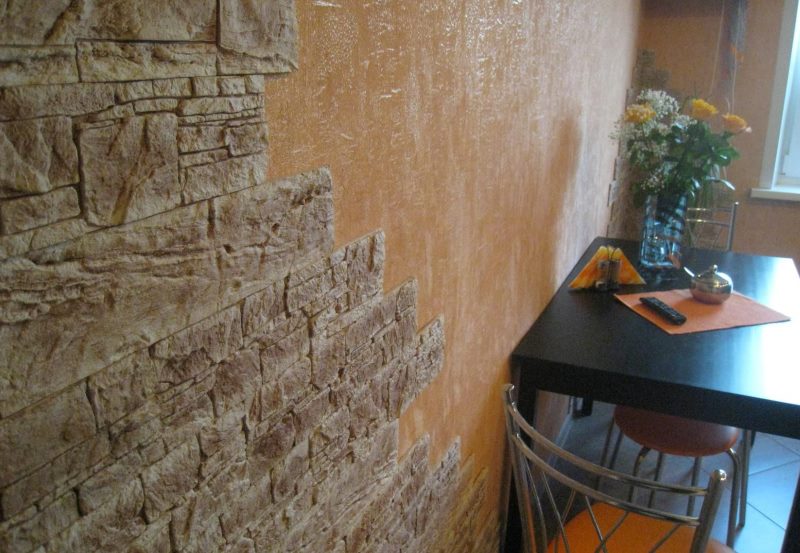
Artificial stone is often used in combination with decorative plaster.
Advantages and disadvantages
All the pros and cons of artificial stone are considered in the table:
| Material | Advantages | disadvantages |
| Porcelain Tiles | wear resistance; resistance to temperature extremes; |
sensitive to strong chemicals. |
| Agglomerates | wide selection of textures and colors; well imitates the structure of natural material; strong; easily tolerates high temperatures; |
the decoration fades in the sun; vulnerable to toxic chemicals; easy to wash. |
| Concrete | relatively low cost; assortment of colors and patterns; long term of operation; easy care; imitates natural a rock; |
does not like high humidity. |
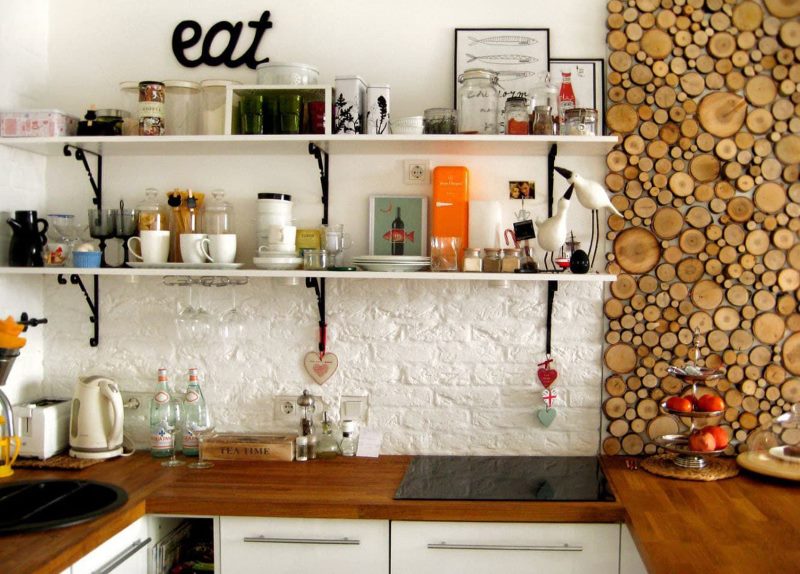
A successful combination of stone with wooden saw cuts
Scope of artificial stone
Due to the large assortment of both colors and textured solutions, stone in the interior of the kitchen has found wide application:
- kitchen apron;
- furniture surface;
- walls;
- openings.
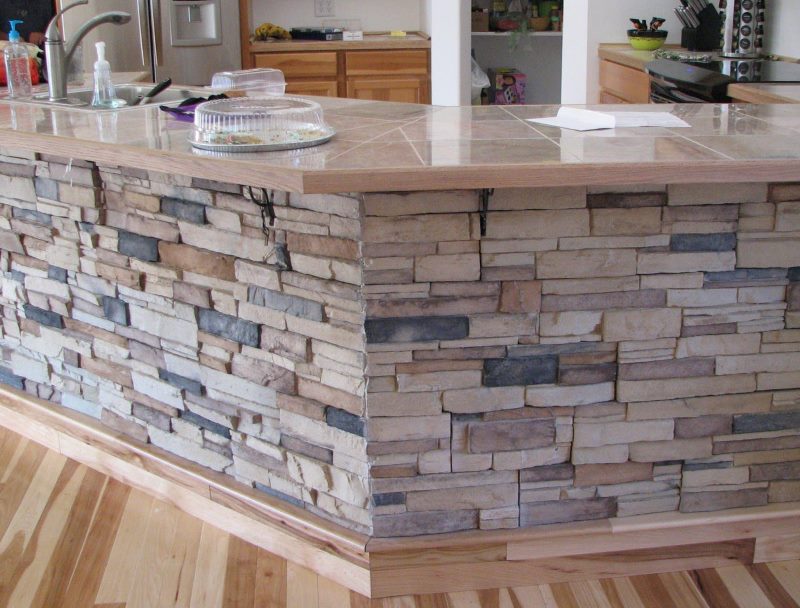
Stone can be faced with a bar counter
It is becoming increasingly popular due to its resistance to damage and ease of maintenance. This is especially important for the kitchen, where surfaces are often dirty during cooking.
Apron in the kitchen
The best option for this work area is easy-to-care material. That is why decorative stone is well suited, due to its resistance to temperature conditions and easy care.

The surface of the apron can be made smooth - such a coating will be easier to wash.

The embossed surface, laid out of individual tiles of different thicknesses, looks gorgeous, but it’s much harder to take care of it
At the same time, such an apron will fit into most interiors:
- Provence
- country;
- loft;
- Mediterranean;
- modern.

Brick-style kitchen is appropriate
Walls
Depending on the style, decorative cladding can be used both to create a separate accent element, and to design the entire area. You can also apply a few different in structure, but similar in shade materials for zoning the room and placement of emphasis. For walls, imitations of brick and masonry made of colored concrete are well suited.

White stone wall decoration will visually increase the kitchen space
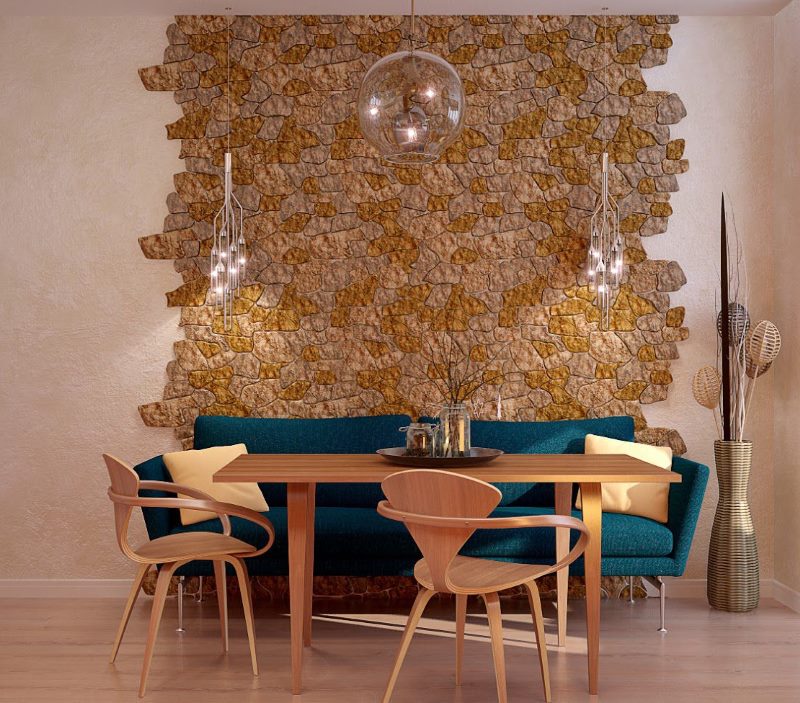
Stylish stone wall decoration in the dining area of the kitchen
Door and window openings
Thanks to the design with a stone, you can visually highlight a door or window, add the illusion of space to the room. Such openings are made out in the form of an arch, and in the standard rectangular version. So you can turn a door or window sill into a separate decorative element. This decor is more suitable for country styles, Provence, minimalism.
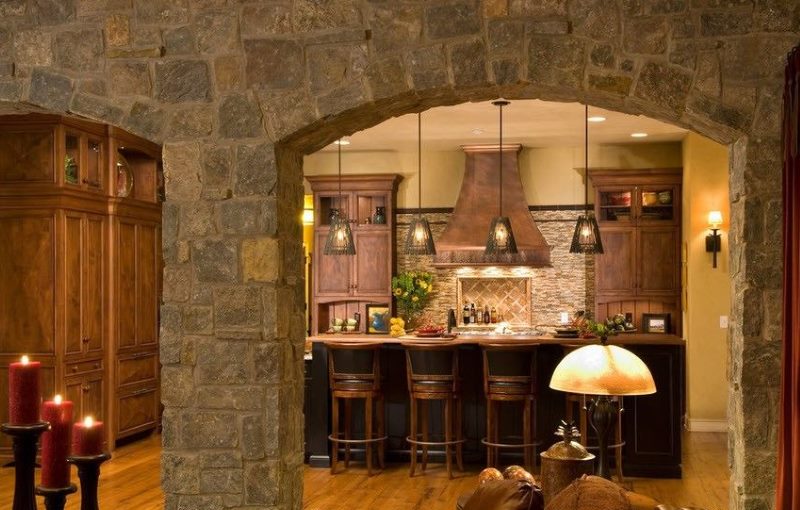
Decorating the entrance to the kitchen with a stone is a great solution

An example of stone finishing a window opening
Ventilation duct
This element of the interior is often difficult to hide, especially given its functional importance. But thanks to the decorative stone, you can refine the box, or create an imitation of a fireplace on its basis.

To make such an imitation of a fireplace is quite simple from drywall, fixed to the frame of galvanized profiles
Such a solution will add coziness to the interior and harmoniously fit into the overall design of the kitchen. However, you should not overdo it and oversaturate the room with decoration, so that it does not seem bulky.
Stone in various interior styles

Imitation of masonry on a neoclassical kitchen apron
Country and Provence
In these styles, rustic motifs prevail. Kitchens with such an interior create a homely cozy atmosphere.

Stone and wood are the most suitable materials for finishing a country-style kitchen
The stone is selected with a rougher texture with convex parts, an imitation of brickwork is also suitable. Hues vary depending on the style, but light colors are preferable. Provence is characterized by colors close to white: beige, cream.

Imitation brickwork with artificial stone in the Provence style kitchen
A stone in these styles decorates a kitchen apron, openings. The hood is disguised as a false fireplace or a rustic stove. Strengthen the rustic flavor will help decorative home decoration and kitchen utensils.
English style
Very noble and elegant version of the interior. In the classic English style, expensive finishing materials are used, such as marble, mother of pearl, malachite. Their combination and the work of artisans made it possible to create a harmonious and cozy atmosphere.
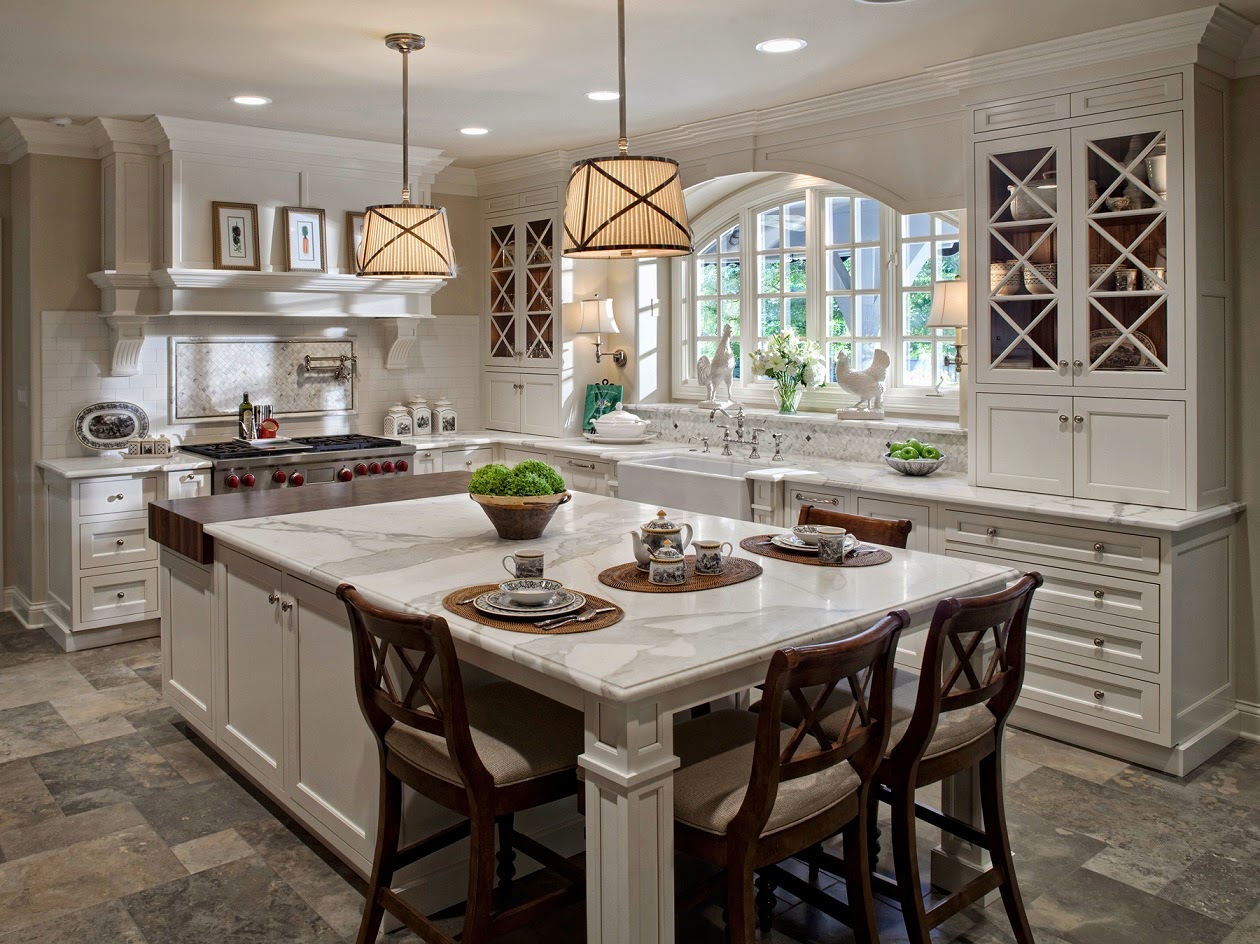
In the English-style kitchen, stone is appropriate primarily on the floor and as a material for countertops
Thanks to the appearance of modern artificial materials that perfectly imitate most minerals, it became possible to recreate the English interior at a lower cost.

Kitchen worktops made of porcelain stoneware to match the wall finish
Porcelain tiles are used for the floor. The apron and countertops are made of agglomerates. The walls can be decorated with artificial savage. Design should be done in pastel colors.
Antique
Also, this style is called ancient Greek. Classic style with prevailing regular geometric proportions. Often a material with the same or similar structure is used for the entire cladding. Mostly used lighter shades, marble tiles predominate.
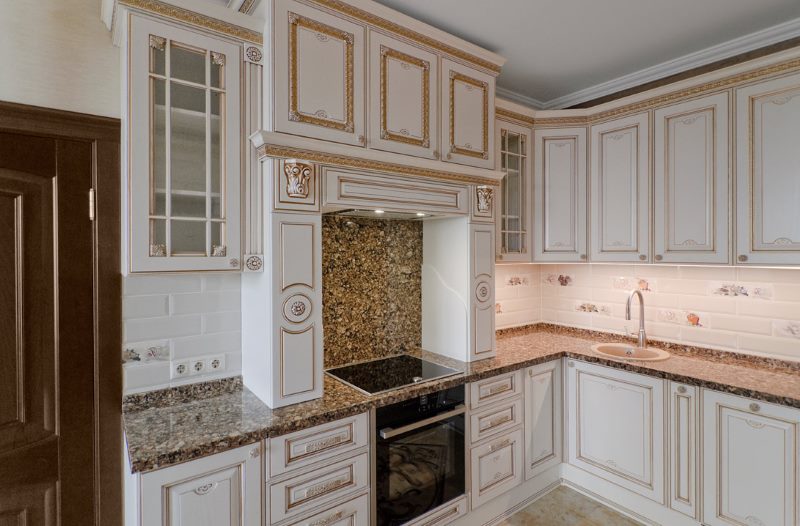
Paired with a classic headset, acrylic stone or granite worktops look great
The interior is characterized by some elements of antiquity: columns, bas-reliefs.Antique style is used in large kitchens with the ability to make arched windows.
Modern
Art Nouveau is characterized by smooth forms, asymmetry in design. In the modern sense of Art Nouveau, there is no excessive luxury and pretentiousness of the 19th century environment. Instead, the style gives a sense of comfort and cheerfulness.

Snow-white Art Nouveau kitchen with acrylic surfaces
Solid stone is more suitable for Art Nouveau, mainly use acrylic. Apply the lining to niches and openings, you can also use it for countertops.
Modern styles
Decorative stone is also used in the interior of modern styles:
- minimalism;
- loft;
- high tech.

An apron made of decorative stone will become a bright accent in the kitchen in the style of minimalism

Making a small loft style kitchen

High-tech requires shine and gloss, which means it is better to use acrylic stone or porcelain stoneware
A common feature for these styles is the desire for minimalism in decor and design. In some cases, styles are even mixed to achieve a design idea. At the same time, artificial stones are used mainly to create accent elements, such as a section of a wall in the form of masonry.
Tips for creating a decorative stone interior
To create a successful and harmonious interior, you should pay attention to a few tips:
- Decorative stone should be used based on the chosen style of the kitchen.
- For stone surfaces, warm dim lighting is better than bright light.
- With a stone, it is better to use warm or pastel colors for other finishes. Bright neon colors ruin his charm.
- When working independently with cladding, you should first try on a small area to get used to the job. It will be easier to complete the work, following the instructions for working with materials.

When choosing your option of stone finishing, you need to focus on the desired appearance and the repair budget
Video with examples of stone wall design





